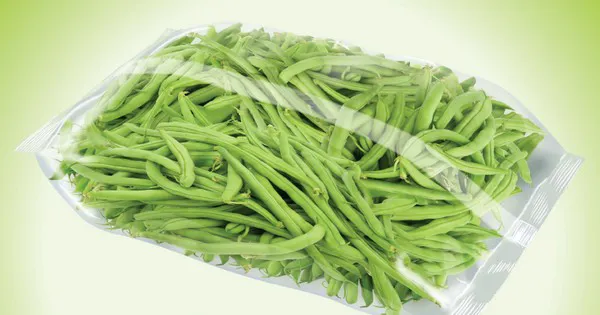The US foodservice industry is discovering the benefits of receiving fresh green bean supplies in lean, modified atmosphere bulk packaging (MAP) newly developed by sustainable packaging experts StePac, Ltd.
The company’s advanced solution under the brand name Xtend® targets food waste in the foodservice supply chain and delivers added benefits of preserving the quality, crispiness, and glossy green color of fresh green beans while maintaining full fresh flavor. Stepac will showcase this at the upcoming Fruit Logistica in Berlin.
Green beans are grown extensively in South Florida and Tennessee, with peak season from November to May. A large percentage of the green beans are packed and shipped to the foodservice industry. But fresh green beans have a short shelf life of around 8 to 12 days. Dehydration, a common post-harvest problem, causes the pods to shrivel and become limp from progressive weight loss and plastic packaging is often used to reduce this waste.

However, excess moisture generated in standard packaging aggravates decay and russeting — reddish-brown spots that result from chilling injury when beans are stored at 5-7.5°C (41-45°F). Foodservice outlets must discard food supplies that do not meet specifications for appearance and quality and are rendered unfit for consumption.
StePac developed modified atmosphere packaging films inbuilt with ideal water vapor transmission rates (WVTR) that eliminate the excess moisture from fresh green bean packaging, mitigating risk of decay and reducing sensitivity to russeting. The company’s proprietary solution also preserves the crispiness and glossy green color of fresh green beans and prevents excessive weight loss caused by dehydration.
“Food waste in the foodservice sector is a major challenge, affecting the entire global food value chain,” notes Gary Ward, Ph.D., Business Development Manager for StePac. “Our technology offers a solution for helping curb that waste. It also isn’t limited to green beans but extends to a range of other vegetables, such as peas, carrots, broccoli, brussels sprouts, and others that are freshly bulk packed exclusively for the foodservice sector.
StePac offers a range of films that cater to nearly every requirement. In addition to Xtend carton liners, its groundbreaking Xflow™ films, with their patented sealing layer, have facilitated applicability for automated packaging, such as vertical form-fill and seal (VFFS) packing. This lets the packaging of green beans and other vegetables meet the demands of high turnover facilities and is already gaining momentum within facilities in regions of the US, especially Florida.
“The new Xflow packaging supports high-speed, high-throughput automated packaging lines for fresh vegetables; supports distributors and growers; and better meets the needs of hotels, restaurants, hospitals, and other institutions across the US,” adds Ward. “Foodservice sites can receive enhanced quality produce while enjoying the benefits of reduced labor costs.”
Meet StePac at Fruit Logistica 2020, Berlin, in hall 26, booth #D10.
For more information:
StePac
Ms. Hila Nagel
Tel: +972.4.612.3500
Email: info@StePac.com
www.StePac.com
